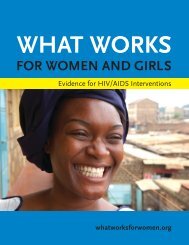Global Tuberculosis Report -- 2012.pdf
Global Tuberculosis Report -- 2012.pdf
Global Tuberculosis Report -- 2012.pdf
Create successful ePaper yourself
Turn your PDF publications into a flip-book with our unique Google optimized e-Paper software.
FIGURE 4.1Progress in implementing surveys foranti-TB drug-resistance in the 27 highMDR-TB and 22 high-TB burden countries2008 2012Afghanistan No data Completed in 2010Bangladesh No data Completed in 2011Belarus No data Completed in 2011Bulgaria No data Completed in 2010Kyrgyzstan No data Completed in 2011Nigeria No data Completed in 2011Pakistan No data OngoingTajikistan No data Completed in 2011DR Congo 1999 No more recent dataIndia 9 States 1 additional StateIndonesia 2 Provinces1 additional Provincein 2010Russian Federation 4 Oblasts 17 additional OblastsAzerbaijan 2007 Planned for 2013Uganda 1997 Completed in 2011Ukraine 2006 Planned for 2013Uzbekistan 2005 Completed in 2011Brazil 1996 OngoingCambodia 2007 No more recent dataChina 2007 Planned for 2013Ethiopia 2005 OngoingKenya 1995 OngoingMozambique 2007 No more recent dataMyanmar 2007 Planned for 2013Philippines 2004 OngoingSouth Africa 2002 OngoingThailand 2006 No more recent dataUR Tanzania 2007 No more recent dataViet Nam 2006 OngoingZimbabwe 1995 Planned for 2013Armenia 2007Moving towardsroutine surveillanceGeorgia 2007 Routine surveillanceKazakhstan 2001 Routine surveillanceRepublic of Moldova 2006 Routine surveillanceEstonia Routine surveillance Routine surveillanceLatvia Routine surveillance Routine surveillanceLithuania Routine surveillance Routine surveillanceSurvey/surveillance at subnational levelNationwide surveyNationwide routine surveillanceof TB: 6.3%; range 3.7–10.0). Six countries (Azerbaijan,the Democratic Republic of the Congo, India, Indonesia,the Russian Federation and Ukraine) still rely on drugresistance surveillance data gathered from limited subnationalareas. In the Democratic Republic of the Congo,logistic issues have prevented the implementation of anationwide survey. In Indonesia, after two surveys at provinciallevel, the national TB control programme (NTP)has opted to work towards establishing a nationwide sentinelsystem to monitor drug resistance. Concrete plansexist in Azerbaijan and Ukraine to start nationwide surveysin 2012. Drug resistance surveys are ongoing inBrazil, Ethiopia, Kenya, Pakistan, the Philippines, SouthAfrica and Viet Nam.By the end of 2011, India and the Russian Federation,which combined with China contribute to almost 60%of the estimated global burden of MDR-TB, had producedreliable data only at subnational level. These countriesshould consider conducting nationwide drug resistancesurveys in the short term to better understand the burdenof MDR-TB and properly plan diagnostic and treatmentservices.Routine surveillance represents the best approach formeasuring drug resistance and monitoring trends. Amongthe 27 high MDR-TB and 22 high TB burden countries,Georgia, Kazakhstan, the Republic of Moldova and theBaltic States now have proper routine surveillance systemsto monitor drug resistance.A group of countries – Benin, Bolivia, Chile, Colombia,El Salvador, Lebanon, Sri Lanka, Mongolia, Nicaraguaand Rwanda – that relied on special surveys to monitordrug resistance have established a routine surveillancesystem for all previously treated cases. This is the firststep towards routine drug susceptibility testing for all TBpatients.Central and Francophone Africa remain the regionswhere drug resistance surveillance data are most lacking,largely as a result of the scarce laboratory infrastructure.4.1.2 Percentage of new and previously treated TBcases that have MDR-TB<strong>Global</strong>ly, 3.7% (2.1–5.2%) of new cases and 20% (13–26%) of previously treated cases are estimated to haveMDR-TB (Chapter 2).The proportions of new TB cases with MDR-TB at countrylevel are shown in Figure 4.2. Proportions ranged from0% to 32.3% and were highest in Belarus (32.3%), Estonia(22.9%), Kazakhstan (30.3%), Kyrgyzstan (26.4%;preliminary results), the Republic of Moldova (19.4%)and Uzbekistan (23.2%). Although the average proportionof patients with MDR-TB in the Russian Federationis lower than in these countries, the proportion is high inseveral oblasts (with Arkhangelsk Oblast at the highestlevel: 35.1% in 2010).The proportion of previously treated TB cases with42 GLOBAL TUBERCULOSIS REPORT 2012
















